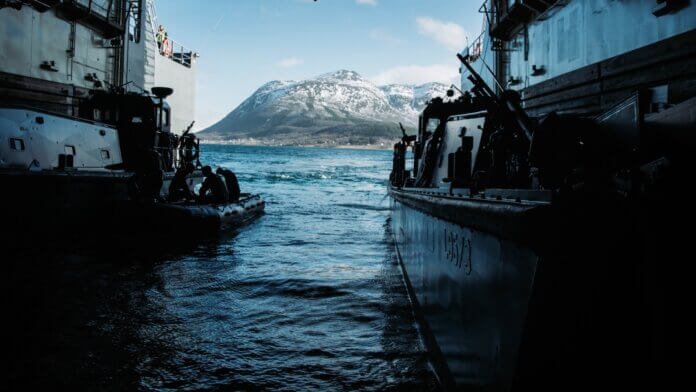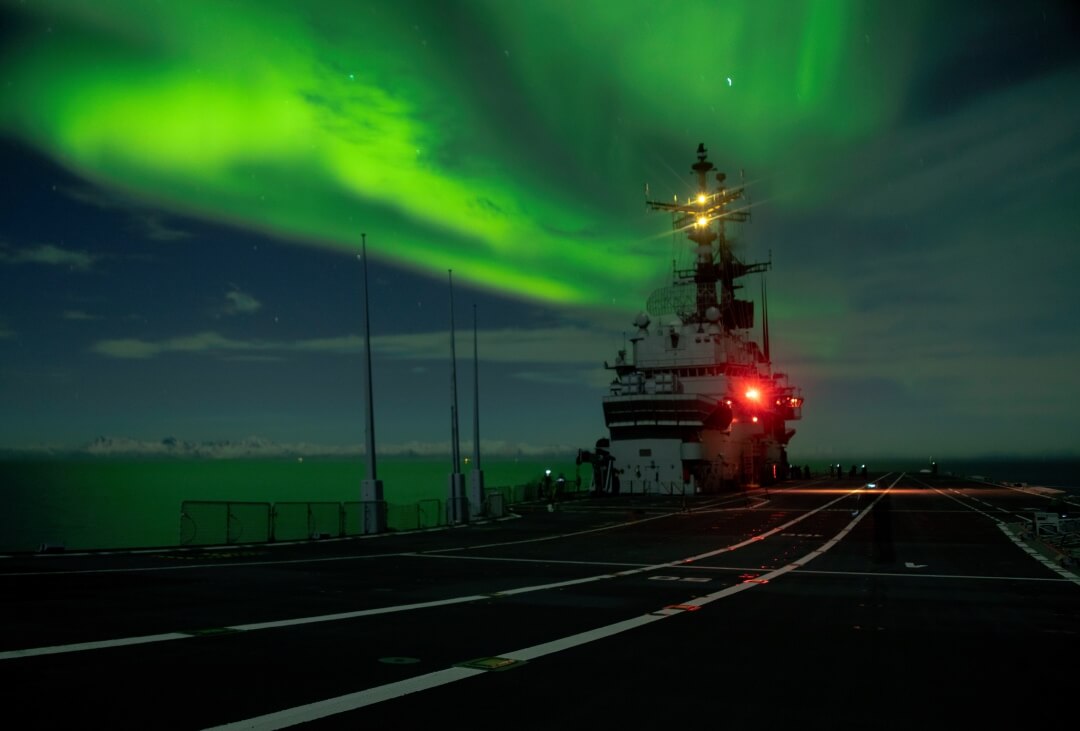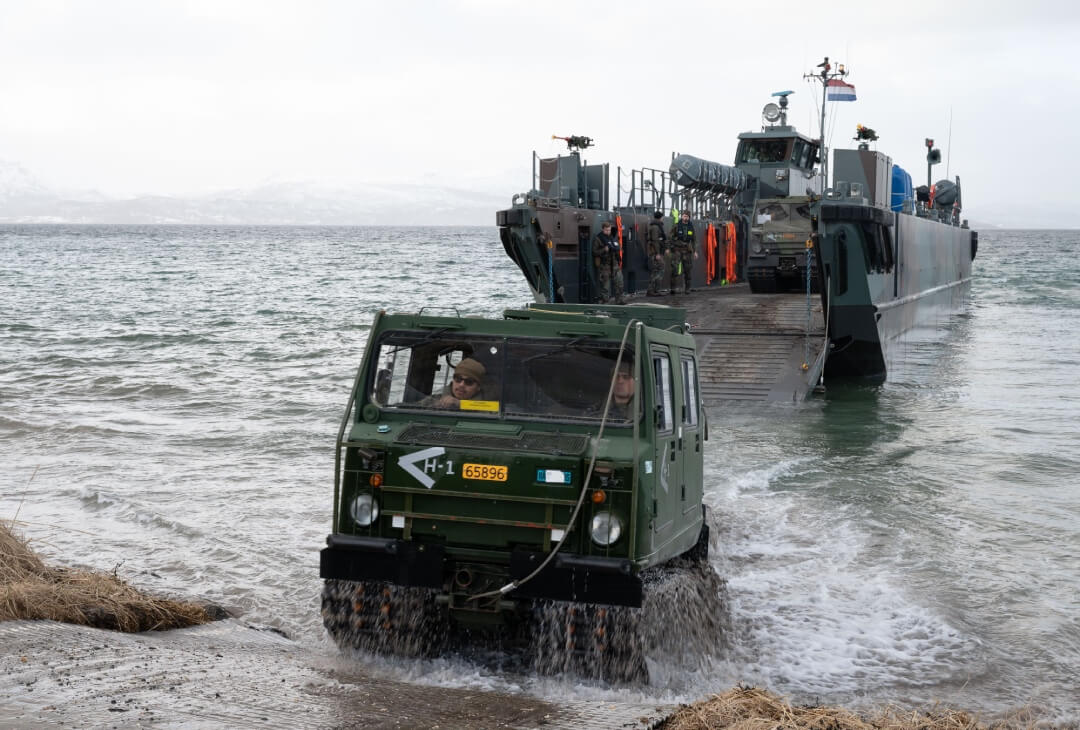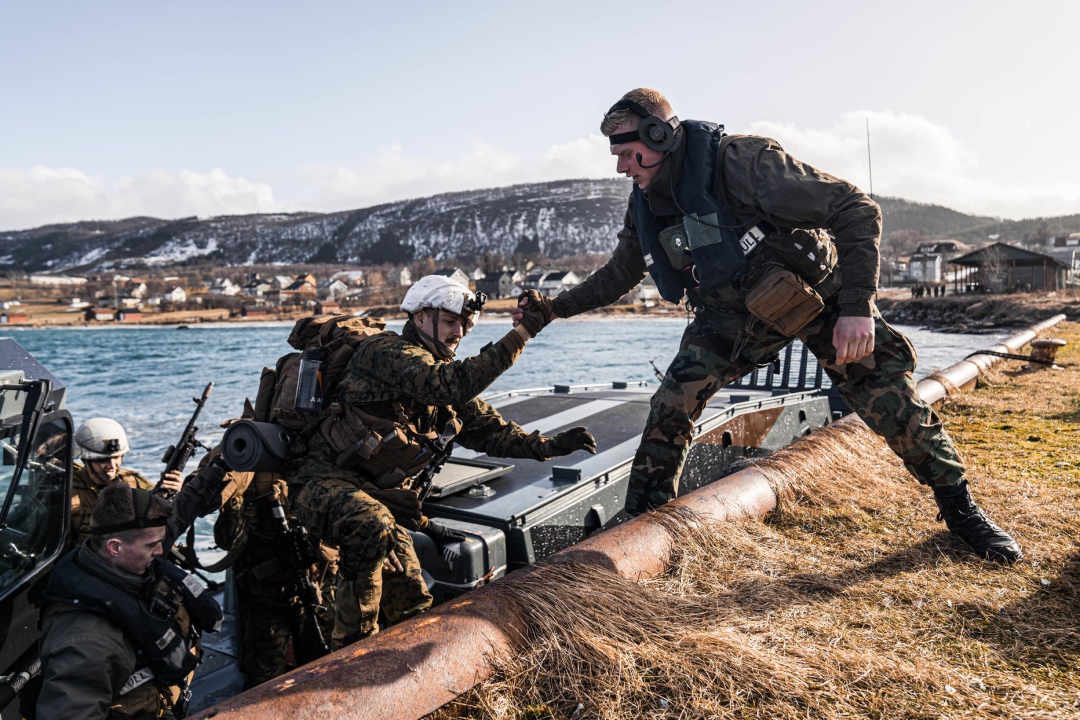
Brigadier General Anthony Henderson, USMC, explains the need to integrate the roles of Commander Amphibious Task Force (CATF) with Commander Landing Force (CLF), set in the context of the recent NATO Exercise Cold Response.
Conducting effective amphibious operations at scale in complex environments is a challenging military task, requiring seamless integration in both command and capability. Such integration at scale was something NATO put to the test in Exercise Cold Response, held in Norway’s northern fjords in March.
The importance of amphibiosity in alliance deterrence and collective defence strategy in the Euro-Atlantic theatre and the need to be able to deliver amphibious force at scale around the alliance’s flanks in support of this strategy was demonstrated by the fact that, for the first time during ‘Cold Response’, three amphibious task groups (ATGs) were present. These task groups – based onboard the Italian Navy (ITN) landing platform helicopter (LPH) amphibious assault ship ITS Giuseppe Garibaldi, the UK Royal Navy landing platform dock (LPD) amphibious vessel HMS Albion, and the Royal Netherlands Navy LPD HNLMS Rotterdam – were brought together under the Commander Amphibious Task Force (CATF), the ITN’s Rear Admiral Valentino Rinaldi, embarked in Garibaldi.
Four amphibious ground force units, drawn from the US Marine Corps’ (USMC’s) 2nd Marine Expeditionary Brigade (MEB), the UK Royal Marines’ 3 Commando Brigade, the Netherlands Korps Mariniers, and the ITN’s San Marco Brigade, deployed from these ATGs under the exercise’s Commander Landing Force (CLF), the USMC’s Brigadier General Anthony Henderson (who was also embarked in Garibaldi).

Ashore, the landing force was opposed by two brigades, the Norwegian Brigade and the Swedish-Finnish Brigade; with these forces working in an integrated manner, this was the first time Cold Response had been conducted with two brigades providing the defensive land force.
Integrating into a coherent whole the ATGs and the amphibious ground force units – and, particularly, the CATF and CLF command structures and staffs – was a major focus of ‘Cold Response’. The exercise underlined and demonstrated the core purpose of amphibiosity: to deliver an effective, integrated landing force ashore from the sea.
High Water Mark
“I’m in disagreement on the division of a role at the high-water mark,” said Brigadier General Henderson who, as well as operating as the CLF in Cold Response, is double-hatted as Commander 2nd MEB and Deputy Commanding General of the USMC’s II Marine Expeditionary Force during an interview with Armada onboard Garibaldi, in Narvik, Norway in late March. Underlining the requirement for integration in command and operational output between the CATF and the CLF, Gen. Henderson explained: “In order for the amphibious task force to succeed, the two leaders must function as a single battle force. Their staffs and their subordinate commands must emulate the same.”
To ensure effective delivery of the landing force component of this amphibious capability, “the CLF role entails the ability as a naval force to project power seaward to landward,” said Gen. Henderson. “That requires that a CLF must understand the seaward side of the manoeuvre and the application of its power in order to set the conditions for landing force [operations], whether contested or even what would be considered uncontested.”
“The CLF must understand the application of military manoeuvre and effects, and then, once landward, apply not only land capabilities but the seaward capabilities of the fleet to achieve the objective,” Gen. Henderson continued. “To do that, I believe that a CLF and a CATF must function as one.”
To ensure seamless integration of CATF and CLF commands and force elements across the high-water mark, various layers of structure, process, and capability must be integrated, including command-and-control (C2) systems and capabilities, operational orders, and staffs, Gen. Henderson explained. “The ways and means are all the above, from systems to process to people,” he said. “The strength we had here with the Italian CATF, I would first start with, was people who had an understanding and a competency of seaward and landward manoeuvre, and fires and effect, and an understanding of the doctrine, using as a starting point the NATO process that is written in the current, 2017 version of the NATO Doctrine.” “We moved forward together from there,” he added.

People and Process
“I started with people, because processes reflect people’s culture, people’s leadership, and guidance. People don’t reflect the process: the process reflects the military culture,” stated Gen. Henderson.
As regards doctrine, Gen. Henderson pointed to an important development in CATF/CLF integration that took place within Cold Response. Some amphibious doctrine that covers the CATF/CLF relationship refers to the roles of and differences between ‘supporting’ and ‘supported’ commands and forces, whereby one command or unit may be perceived as ‘supporting’ another command or unit (which becomes the ‘supported’ element). While teaching a ‘supporting’ and ‘supported’ framework to marines and sailors is important in building understanding of the approach to conducting amphibious operations, it should be seen as a spirit of that approach rather than hard guidance for it, Gen. Henderson explained. Using a ‘supporting’ and ‘supported’ framework can create a perception that one command makes decisions over another. “Admiral Rinaldi and I removed that construct, to make it understood by the people of the staffs, of the ships, and of the subordinate forces that it is an integrated, mutual analysis and commanders’ decision that we had to agree upon, discuss, debate, compromise, and understand,” he said. “Those steps are what’s necessary when you have two entities coming together like a CATF and a CLF, whether they have been working together for months and years or coming together in the moment of an event; those steps are necessary in order for the two entities to function as a single battle approach.”

Gen. Henderson argued that creating the single battle approach by removing any command seams is important in building advanced warfighting ability. “If you’re going to operate at an advanced level [such as] up in the Norwegian Sea, relative to the terrain of Norway, that requires you to have that type of advanced skill thought as commanders, because it’s a very, very challenging environment,” said Gen Henderson.
“In the ‘Cold Response’ scenario, the adversary was also very challenging,” he added. The demanding nature of the operational environment and operational scenario mandated the need for seamless command and force integration to deliver and demonstrate advanced amphibious capability and operational effect, Gen. Henderson explained. “The decisions we made on the timings of the execution were mutual positions [between the CATF and the CLF].” As regards the conduct of any amphibious assaults, while the CATF would have understanding of the landing conditions in the amphibious operating area (AOA), “the CLF has significant input because the AOA may have sufficiency for naval ship manoeuvre but insufficiency for landing forces to gain control of the landing beach and other objectives,” he said. For example, an adversary’s aviation may not be able to affect the ATG ships if they are well positioned and defended, but might still be able to affect or deny the beach to the landing force. During Cold Response, Gen. Henderson explained, “The CATF and the CLF reached agreements on targeting that were designed to not only reduce the threat to ATG shipping but to the ability of the landing force to get ashore and get a foothold, so it can conduct its operation.”
“That’s what I mean by treating it as one continuous battle approach,” he concluded.
Multinational Integration
Alongside closing any seams between the CATF and the CLF, including in doctrinal terms, Cold Response also presented an opportunity to integrate the various amphibious doctrinal and operational constructs being developed by NATO’s major amphibious forces.
The USMC has developed several separate but inter-related constructs, namely Expeditionary Advanced Base Operations (EABO), Distributed Maritime Operations (DMO), and Littoral Operations in a Contested Environment (LOCE). The UK Royal Marines is developing its Littoral Strike/Future Commando Force (LS/FCF) concept and capability. The Royal Netherlands Navy’s Korps Mariniers has been developing its Future Littoral Operating Concept (FLitOC). The various concepts and approaches raised the question of their integration during Cold Response and in wider NATO amphibious capability development.

“We’ve discussed a bit of amphibiosity from the science perspective,” said Gen. Henderson. “The interoperability of the current and future capabilities of multinational forces is really the art.”
“How do I take what is the strength of one country’s amphibious capability and apply it in a way that also supports and protects the limitations of another’s, and advances the overall capabilities of the amphibious task force (ATF),” he questioned.
Using the UK’s LS/FCF construct as an example of how emerging force concepts can enable what could be considered as more traditional amphibious forces and approaches, Gen Henderson explained: “LS/FCF is designed as an advanced force, multi-modal, with deep-penetrating capability. That capability provides an understanding of the operating area and support to shape, through all-domain targeting means, that operating area.” “If you use that in advance of establishing or occupying the AOA, it helps you to set the conditions for other amphibious forces that may have skills relating more to the traditional seizure of ground – landing, holding positions, and manoeuvring against a land opponent,” said Gen. Henderson. “So, that advanced force, blended with what could be considered a more traditional integrated manoeuvre force, allows you to understand the battlespace and get the force ashore with potentially less risk to the larger force.”
“If you look at the Dutch concept, [when used] in conjunction with the German Sea Battalion, those are highly skilled naval ship-to-shore forces that can reduce an adversary’s high-threat positions, whether they are mines or other types of systems,” observed Gen. Henderson. “When you add this to the USMC capability we currently have and the capability we would advance in the future – our current capability to seize ground against a formidable, contesting enemy, and our ability to manoeuvre air and surface assets as an integrated combined arms force – those give the CATF and the CLF a lot of very capable options that most modern military forces don’t have…That’s the real power of the interoperability of NATO,” he said.

NATO’s NALES
NATO’s overall framework for integrating alliance amphibious capability is the NATO Amphibious Leaders Expeditionary Symposium (NALES) C2 construct.
NALES, which began development in 2016 and has been demonstrated previously on the US Navy (USN)-led BALTOPS exercise in 2019 and 2020, brings a requirement to develop C2 integration in amphibious operations to enable integration of national amphibious forces to deliver capability at scale for deterrence and collective defence. To achieve this, NALES is focused at several levels: to enable the seamless integration of CATF and CLF command components at ATG and ATF levels; to enable integration between multiple ATGs, particularly when they are operating together as part of a larger ATF; and, broadly, to improve integration between US and European amphibious forces.
Exercises and wider experimentation play a significant role in NALES development, and this framework will help alliance amphibious forces to address collectively what they need to do in taking NALES forward. “How do we get NALES going through its series of experimentations that develop a capability and a doctrine for how we blend those [different] types of ATGs?” Gen. Henderson asked. “We have to do a lot more experimentation, and we have to be very deliberate in that experimentation. We need to focus on our logistics and on our C4I systems, in order to enable all of the different countries’ capabilities that are built for their national interests to be a capability as a part of NATO.”
Future Requirement
The Alliance’s high-level focus on Cold Response and on the enduring need to maintain the flexibility to project power ashore from the sea around NATO’s flanks underline the continuing requirement for amphibious capability into the future. This requirement is further underscored by the emergence of the various new amphibious concepts, as well as (in the United States’ case) increasing strategic and operational integration between the USMC and USN.
The USMC’s EABO, DMO, and LOCE concepts all require for the seaward and landward force elements to be integrated. “As we distribute the fleet and it ‘pulses in’, it is ‘pulsing’ into somewhere, and the majority of requirements will require a ‘pulse’ in towards the littoral – but you can’t find yourself standing at the water’s edge unable to dominate your opponent landward,” said Gen. Henderson.
In terms of USN/USMC integration and amphibious operations more broadly, Gen. Henderson noted: “Naval power requires the ability to not only sustain freedom of navigation in peace and conflict, but in conflict the ability to project power ashore if you intend to shape the situation relative to your key and vital interests….That shaping and that projection ashore requires a viable land force … because the majority of those places that become contested are landward,” he added.
by Dr. Lee Willett












